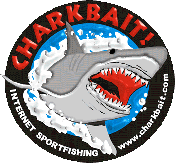|
|
Fishermen's Journal |
ALBACORE TROLLING TIPS
by Bob Hoose, Sevenstrand Tackle Corp.
Jig Selection
 You
simply cant go wrong by "matching the hatch" when albacore fishing. An
effective way to determine what the albacore are feeding on is to arrive on the fishing
grounds in the dark. Turn on your deck lights and see what kind of bait builds under
the boat. It could be small 3" squid, anchovies, sauries, sardines, or a
combination of all four. If you see mostly small fin
You
simply cant go wrong by "matching the hatch" when albacore fishing. An
effective way to determine what the albacore are feeding on is to arrive on the fishing
grounds in the dark. Turn on your deck lights and see what kind of bait builds under
the boat. It could be small 3" squid, anchovies, sauries, sardines, or a
combination of all four. If you see mostly small fin
fish, I have had good success with a couple of our Mini Feathers in purple/black, loco
joe, mexican flag, blue grunt, and zucchini. If the small suid are present, our
carmel delight Mini Feather is a perfect match. If 4-6 inch sardines or sauries show
up in the lights, our Tuna Clones, Tuna Feathers, and Tuna Clone Feathers are an excellent
choice. These should be mixed in with the smaller Mini Feathers to improve the
appearance and effectiveness of your trolling pattern. Another key aspect of jig
selection is find out what color or pattern is hot at the time.
7STRAND charter / field test boats:
LIMITLESS in Dana Point, FIN FEVER in Newport Beach, and TONNAGE in Long Beach are out
regularly testing our products and relaying info regardiwhat colors and lures are
producing each week. We take this info and try our best to post it and pass along to the
tackle stores to aid customers in jig selection. It changes constantly, so having a
wide selection of colors and styles will prepare you for almost any
condition. Another important but often overlooked aspect of jig fishing is to have
confidence in your trolling lure selections and patterns. If you have confidence in
7STRAND products, have had success in the past with a specific color or style, theres a
good chance that lure will continue to produce for you. Keep that in mind, and also
dont be afraid to experiment or
try new things.
Trolling Patterns
The best trolling speed for us is 6-7.5 knots. If your running or scouting
for signs, 8-10 knots is a good speed to run until you find signs or fish. Every
boat has a different wake depending on their size and prop systems, so choose a pattern
that puts your jigs in the "blue holes" that are created at trolling speed.
Outboards have a great deal of turbulence off the center of the transom, so placing
the outside rods short and the inside rods long seems to work well. On inboards,
there is a much cleaner wake so your traditional " w " pattern will put the jigs
in clean water where albacore can see them. Since each boat is different, the
distance is determined by where the jig swims best. I like my short jigs on the
second or third wake back, and the outside lines on the third and fourth. If your
jig is skipping out of the water too often, try using AFTCO roller troller to lower the
angle and help keep the jig under the surface. Furthermore, placing a cenetr stinger
or whiskey line down the middle long can increase your number of hook ups.
Leaders and Rigging
The hottest thing going is Fluoro Carbon leaders on your trolling gear. It will make
a difference on the number of hook ups and really is effective when the bites slow or the
fish line shy. Fluoro Carbon leaders of 60-80# lb. seems best for albacore, and we
have had even better success using leader as light as 30# on both the Mini Feathers and
Tuna Clones. If your using
7STRAND crimps, be sure that the crimp is sized properly to the leader material.
Aluminum or copper sleeves both work well with our HS 250 swaging tool. A 6-8
foot leader is about right for albacore and also helps gaffing a fish on a small
boat. Hooks can be either traditional double or singles. I prefer the single
Siwash or the Mustad 7691's because of their superior
holding strength. Several times in the past I found the double hook can pull when
wiring a bluefin or big eye. Also, if your in the catch & release mode the
single does far less damage to the fish.
Tips
After a jig strike, keeping the boagoing can increase your odds of multiple hook ups.
If you encounter a blue whale, albacore will sometimes feed on the krill that spill
out of the whales mouth while feeding. Troll your jigs over the boil after the whale
has made its descent, and you will often get albacore bit. If nmarking fish deep on
the meter, try figure eight turns
while chumming pieces of cut anchovy. This creates a "ladder" for the fish
to follow to the surface. Leaving a hooked fish in the water will often hold a
school of albies while additional fish can be baited. After boating your first
albacore, take a moment to check its stomach contents to see what kind of feed is in the
area. Bleeding and icing your catch can make a huge
difference in the quality and flavor of this tasty tuna.
GOOD LUCK AND THANKS FOR THE SUPPORT!
Bob Hoose
Sevenstrand tackle Corporation

